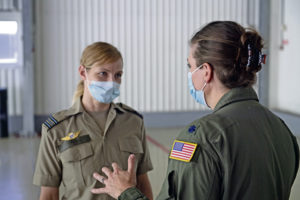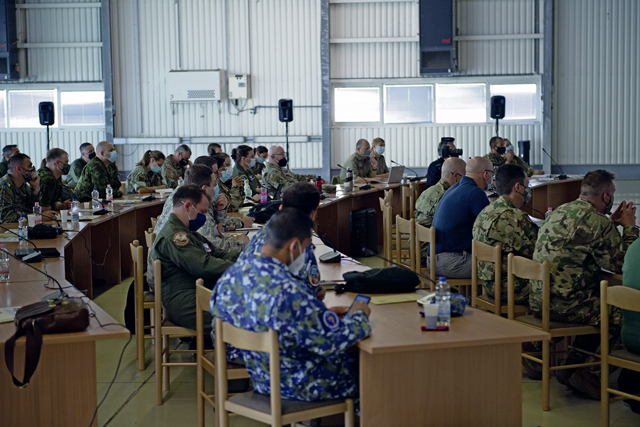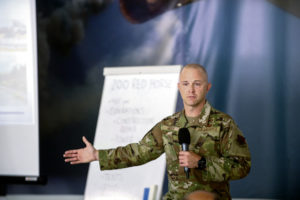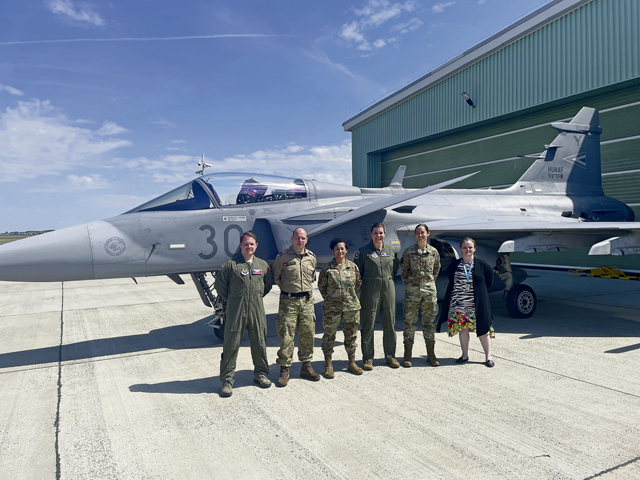
The Hungarian air force co-hosted European Partnership Flight 2021 alongside United States Air Forces in Europe – Air Forces Africa at Kecskemét Air Base, Hungary, from June 6-12.
The event brought together air force delegates from across the European theater, including Bosnia and Herzegovina, Bulgaria, Croatia, Denmark, Estonia, Latvia, Lithuania, Hungary, Poland, Romania, Slovakia and the U.S.
As Hungarian JAS 39 Gripen fighters conducted routine flying operations above, EPF participants gathered in a nearby hangar to brief and discuss the Agile Combat Employment concept. Leaders from different nations presented several aspects of ACE support with a special focus on flying and logistics operations.

“It has been a good opportunity to share with the other nations from NATO’s eastern regions,” said Lt. Col. László Banka, Commander of the Air Operations Support Battalion for Hungarian Defense Forces 59 at Szentgyörgyi Dezsö Air Base. “For example, Hungary was able to share its experience with Baltic air policing deployments from 2015 and 2019.”
Throughout the event, air force delegates from all attending countries brought their individual expertise and national perspectives on various topics concerning the rapid deployment of aircraft in the European theater.
“One of the most beneficial portions was being able to identify, in more detail, the requirements we may need to improve for our host nation capability,” said Banka.
While strengthening partnerships continues to be at the EPF program’s forefront, this event looked different from its predecessors. This particular event’s focus was to bring in air force leaders who are intimately familiar with the processes to enable mutually supported ACE operations.
“These captains and colonels are the people most familiar with what their bases have to host other nations, and what their forces will need to support visiting forces,” said Mr. Leo Kowatch, USAFE-AFAFRICA senior strategy analyst. “Although they discussed many logistics and technical issues, new friendships were the most important result.”
The EPF event sought to form new relationships, but old bonds were also strengthened throughout the week. Air National Guard Airmen from Ohio came to brief ACE concepts as well.
The Ohio ANG has been partnered with the HDF for 28 years as part of the Department of Defense’s State Partnership Program.

“Not only did we get to expand and strengthen our partnership with Hungary and learn more about their air capabilities, we were able to do the same thing with our other partner nations,” said Air National Guard Maj. Eric Hoelle, 200th Red Horse Squadron director of operations. “It’s been a great opportunity for us to learn more about them and for them to learn about us.”
Throughout the week, participants worked in collaborative workshops with personnel representing a variety of disciplines.
“The overarching goal with these partnership flights is being able to get the different partner nations and allies to be able to work together,” said Master Sgt. Brandon Stubblefield, 435th Contingency Response Support Squadron operations superintendent. “The goal is for them to become partners that want to work together, know how to work together, and have some new contacts.”
The series of workshops and practical events provided opportunities for partner nations to collaborate in an interactive environment while sharing unique perspectives on aircraft deployments.

“From our perspective, this workshop co-hosted by USAFE and the Hungarian air force significantly improved our vision of the future capabilities and requirements necessary for closer cooperation between the allies in the Central European airspace,” said Slovakian air force Col. Robert Tibensky, Chief Coordinator of the F-16 Program in the Slovak Armed Forces and senior military advisor to the Chief of Defense.
“For Slovakia, better understanding of ACE operational concept and the presented information from participating countries about providing their national host nation support gave us better understanding of how to improve the current infrastructure at our main air bases which will receive the brand new fleet of the Slovak Falcons and have to provide HNS for allies as well.”
The event’s closing workshop had participating countries employ the discussed ACE concepts by responding to simulated scenarios and prompts.
“One of the biggest takeaways is that we have to work together to make deterrence work,” Banka said.
All nations present shared the different capabilities they had to host other forces, giving a better picture of how the partner nations could support each other in employing successful ACE operations.
“This course was invaluable in advancing our ability to understand the needs of a deploying force and consequently developing an integrated support plan leveraging the capabilities of all participating nations,” said U.S. Air Force Col. Jason Work, 435th Contingency Response Group commander.
USAFE-AFAFRICA continues to invest in its strategic partnerships with key allies in Europe and aims to enhance collective defense posture, regional cooperation and interoperability.



